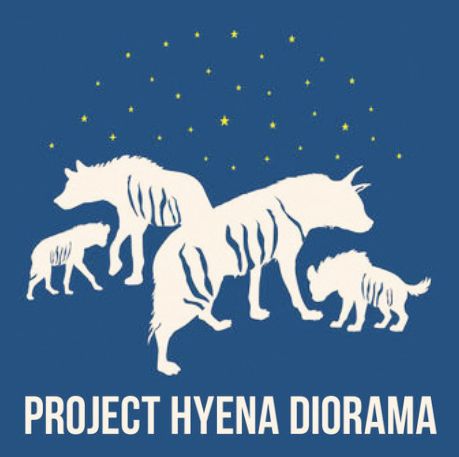The Field Museum wants a new diorama for some old specimens 
How much would you give so a dead hyena could have a new home?
The Field Museum of Natural History is hoping you’ll give something. The museum – a world institution that, happily, happens to be in Chicago – is raising $170,000 via crowdfunding to build a classic animal diorama featuring striped hyenas in the museum’s Hall of Asian Mammals. The display will be the first new large animal diorama at the Field in more than 20 years.
Anyone who grew up in Springfield, or even who visited here on school tours, will remember less exotic creatures similarly displayed at the Illinois State Museum. There, bison and bobcats and black bears and river otters cavorted in ecologically accurate settings contrived by masters of paint, hide, clay and wood. With dozens of plant and animal species shown in context and combination, they reward careful and repeated looking of the sort that is conducive to reflection; more subtly, they represent in physical form the intellectual truth that ecosystems are crowded and complex and (so artfully are the actors in these mini-dramas posed) dynamic.
Not that it was curiosity about ecology that drew me back to look at them again and again. If you were a typical boy of 10 or so, as so many of us were doomed to be, you thrilled to the bobcat carrying the bloodied corpse of what I remember was a ground squirrel in its mouth. This was science come alive.
I am told that the ISM had offered dioramas of animal and Indian life as far back as the 1920s. The earliest of these, however, were built a generation after the art of staging animal dramas in faithfully realistic settings had been perfected, and that perfection was achieved up the road from Springfield.
Pioneering taxidermist Carl Akeley was driven by what has been called a “mummy complex,” or the obsession to freeze in permanent form life itself. Attempting to do that at the Field Museum from 1896 to 1909, Akeley invented the dioramic arts. The “Fighting African Elephants” in the Stanley Field Hall is by Akeley. He also mounted white-tailed deer – then an endangered species in Illinois – in each of the four seasons; museum pros regard this display as “the Mona Lisa of taxidermy mounts.” (Most of the individual leaves in the trees, some 17,000 of them, were individually cast using one of Akeley’s patented methods.) Teddy Roosevelt, who so loved to make live animals dead, was so impressed by Akeley’s skill at making dead animals seem alive that he invited Akeley to the White House.
The success of Akeley’s displays excited other museums to attempt the same, or at least to dream about it. The 1908 biennial report of the Illinois State Museum listed the many large mammals, once common in Illinois, that ought to be displayed for the edification of Illinoisans of the modern day. “When a collection of these animals is suggested to the average man there appears before his mind’s eye a series of stiff, ungainly, ill-formed, moth-eaten animals standing on ugly wooden supports and herded together in a manner more intimate than is expected to be seen at the time when the lion and the lamb lie down together,” wrote the anonymous author (probably curator A.R. Crook). “It should be a picture as might represent a group of buffalo browsing on prairie grass or of a deer family just coming through the woods and standing at attention.” It was such a picture that schoolkids like me finally saw in the 1960s.
As did so many talented Chicagoans, Akeley split for New York City, in 1909. The master did wonderful work for the American Museum of Natural History on Manhattan’s Upper West Side. (In The Catcher in the Rye, young Holden Caulfield recalls his many visits to the Natural History Museum to see the Akeley dioramas.) What is now known as the Akeley Hall of African Mammals comprises 28 habitat dioramas that are “perhaps a kind of apotheosis of art and science in terms of craftsmanship,” in the words of the museum’s provost.
A good taxidermist must be a good sculptor, Akeley argued, and he was; in terms of musculature and coloring and poses, his dead animals are close to alive in appearance. An observant naturalist, Akeley also brought a touch of dramaturge to his work; the group of eight elephants he did for New York’s Museum of Natural History leave one feeling they might charge you any moment.
Those striped hyenas to whom the Field wants to give a proper home were done by Akeley. So send ’em a few bucks at https:// www.indiegogo.com/projects/project-hyenadiorama before May 5. And while you’re online, drop by The Brain Scoop, the Field’s in-house YouTube channel (https://www. youtube.com/user/thebrainscoop). There you will meet Emily Graslie, the museum Chief Curiosity Correspondent. Anyone who thinks museums are dull places filled with dead things hasn’t met Emily.
Contact James Krohe Jr. at [email protected].
Editor’s noteAs Gov. Bruce Rauner fi nishes his 100th day of wreaking havoc on the
Illinois budget, Illinoisans are beginning to realize they got what they
voted for. Rauner has used the authority given him by the Illinois
General Assembly to slash spending in the current fi scal year, while
proposing cuts for the next fi scal year. The governor says he feels
“terrible” about cuts to autism programs and state payments for burial
of the indigent, but Pat Quinn had a dishonest budget. Rauner’s budget
director apologized for any misunderstanding about cuts, but after the
apology the cuts remain in place. There won’t be any revenue increases
until after Rauner’s “turnaround agenda” is enacted, so we’re in for a
long season of bargaining over the governor’s mostly anti-union agenda.
None of this turmoil would have happened had Pat Quinn been re-elected.
But voters knew that and voted for turmoil anyway. –Fletcher Farrar,
editor and publisher